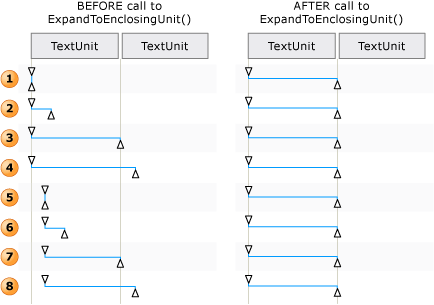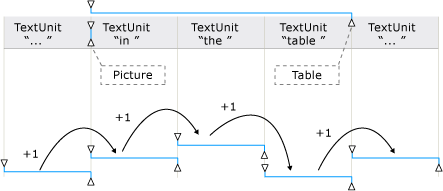TextPatternRange.Move(TextUnit, Int32) Méthode
Définition
Important
Certaines informations portent sur la préversion du produit qui est susceptible d’être en grande partie modifiée avant sa publication. Microsoft exclut toute garantie, expresse ou implicite, concernant les informations fournies ici.
Déplace la plage de texte du nombre spécifié d'unités de texte.
public:
int Move(System::Windows::Automation::Text::TextUnit unit, int count);public int Move (System.Windows.Automation.Text.TextUnit unit, int count);member this.Move : System.Windows.Automation.Text.TextUnit * int -> intPublic Function Move (unit As TextUnit, count As Integer) As IntegerParamètres
- unit
- TextUnit
Limite d'unité de texte.
- count
- Int32
Nombre d'unités de texte à déplacer. Une valeur positive déplace la plage de texte vers l'avant, une valeur négative déplace la plage de texte vers l'arrière. 0 n'a aucun effet.
Retours
Nombre d'unités réellement déplacées. Ce peut être moins que le nombre requis si l'un ou l'autre des nouveaux points de terminaison de plage de texte est supérieur ou inférieur aux points de terminaison de DocumentRange.
Exemples
/// -------------------------------------------------------------------
/// <summary>
/// Starts the target application and returns the AutomationElement
/// obtained from the targets window handle.
/// </summary>
/// <param name="exe">
/// The target application.
/// </param>
/// <param name="filename">
/// The text file to be opened in the target application
/// </param>
/// <returns>
/// An AutomationElement representing the target application.
/// </returns>
/// -------------------------------------------------------------------
private AutomationElement StartTarget(string exe, string filename)
{
// Start text editor and load with a text file.
Process p = Process.Start(exe, filename);
// targetApp --> the root AutomationElement.
AutomationElement targetApp =
AutomationElement.FromHandle(p.MainWindowHandle);
return targetApp;
}
''' -------------------------------------------------------------------
''' <summary>
''' Starts the target application and returns the AutomationElement
''' obtained from the targets window handle.
''' </summary>
''' <param name="exe">
''' The target application.
''' </param>
''' <param name="filename">
''' The text file to be opened in the target application
''' </param>
''' <returns>
''' An AutomationElement representing the target application.
''' </returns>
''' -------------------------------------------------------------------
Private Function StartTarget( _
ByVal exe As String, ByVal filename As String) As AutomationElement
' Start text editor and load with a text file.
Dim p As Process = Process.Start(exe, filename)
' targetApp --> the root AutomationElement.
Dim targetApp As AutomationElement
targetApp = AutomationElement.FromHandle(p.MainWindowHandle)
Return targetApp
End Function
/// -------------------------------------------------------------------
/// <summary>
/// Obtain the text control of interest from the target application.
/// </summary>
/// <param name="targetApp">
/// The target application.
/// </param>
/// <returns>
/// An AutomationElement that represents a text provider..
/// </returns>
/// -------------------------------------------------------------------
private AutomationElement GetTextElement(AutomationElement targetApp)
{
// The control type we're looking for; in this case 'Document'
PropertyCondition cond1 =
new PropertyCondition(
AutomationElement.ControlTypeProperty,
ControlType.Document);
// The control pattern of interest; in this case 'TextPattern'.
PropertyCondition cond2 =
new PropertyCondition(
AutomationElement.IsTextPatternAvailableProperty,
true);
AndCondition textCondition = new AndCondition(cond1, cond2);
AutomationElement targetTextElement =
targetApp.FindFirst(TreeScope.Descendants, textCondition);
// If targetText is null then a suitable text control was not found.
return targetTextElement;
}
''' -------------------------------------------------------------------
''' <summary>
''' Obtain the text control of interest from the target application.
''' </summary>
''' <param name="targetApp">
''' The target application.
''' </param>
''' <returns>
''' An AutomationElement. representing a text control.
''' </returns>
''' -------------------------------------------------------------------
Private Function GetTextElement(ByVal targetApp As AutomationElement) As AutomationElement
' The control type we're looking for; in this case 'Document'
Dim cond1 As PropertyCondition = _
New PropertyCondition( _
AutomationElement.ControlTypeProperty, _
ControlType.Document)
' The control pattern of interest; in this case 'TextPattern'.
Dim cond2 As PropertyCondition = _
New PropertyCondition( _
AutomationElement.IsTextPatternAvailableProperty, _
True)
Dim textCondition As AndCondition = New AndCondition(cond1, cond2)
Dim targetTextElement As AutomationElement = _
targetApp.FindFirst(TreeScope.Descendants, textCondition)
' If targetText is null then a suitable text control was not found.
Return targetTextElement
End Function
/// -------------------------------------------------------------------
/// <summary>
/// Moves a text range a specified number of text units. The text range
/// is the current selection.
/// </summary>
/// <param name="targetTextElement">
/// The AutomationElment that represents a text control.
/// </param>
/// <param name="textUnit">
/// The text unit value.
/// </param>
/// <param name="units">
/// The number of text units to move.
/// </param>
/// <param name="direction">
/// Direction to move the text range. Valid values are -1, 0, 1.
/// </param>
/// <returns>
/// The number of text units actually moved. This can be less than the
/// number requested if either of the new text range endpoints is
/// greater than or less than the DocumentRange endpoints.
/// </returns>
/// <remarks>
/// Moving the text range does not modify the text source in any way.
/// Only the text range starting and ending endpoints are modified.
/// </remarks>
/// -------------------------------------------------------------------
private Int32 MoveSelection(
AutomationElement targetTextElement,
TextUnit textUnit,
int units,
int direction)
{
TextPattern textPattern =
targetTextElement.GetCurrentPattern(TextPattern.Pattern)
as TextPattern;
if (textPattern == null)
{
// Target control doesn't support TextPattern.
return -1;
}
TextPatternRange[] currentSelection = textPattern.GetSelection();
if (currentSelection.Length > 1)
{
// For this example, we cannot move more than one text range.
return -1;
}
return currentSelection[0].Move(textUnit, Math.Sign(direction) * units);
}
''' -------------------------------------------------------------------
''' <summary>
''' Moves a text range a specified number of text units.
''' </summary>
''' <param name="targetTextElement">
''' The AutomationElement that represents a text control.
''' </param>
''' <param name="textUnit">
''' The text unit value.
''' </param>
''' <param name="units">
''' The number of text units to move.
''' </param>
''' <param name="direction">
''' Direction to move the text range. Valid values are -1, 0, 1.
''' </param>
''' <returns>
''' The number of text units actually moved. This can be less than the
''' number requested if either of the new text range endpoints is
''' greater than or less than the DocumentRange endpoints.
''' </returns>
''' <remarks>
''' Moving the text range does not modify the text source in any way.
''' Only the text range starting and ending endpoints are modified.
''' </remarks>
''' -------------------------------------------------------------------
Private Function MoveSelection( _
ByVal targetTextElement As AutomationElement, _
ByVal textUnit As TextUnit, _
ByVal units As Integer, _
ByVal direction As Integer) As Integer
Dim textPattern As TextPattern = _
DirectCast( _
targetTextElement.GetCurrentPattern(textPattern.Pattern), _
TextPattern)
If (textPattern Is Nothing) Then
' Target control doesn't support TextPattern.
Return -1
End If
Dim currentSelection As TextPatternRange() = _
textPattern.GetSelection()
If (currentSelection.Length > 1) Then
' For this example, we cannot move more than one text range.
Return -1
End If
Return currentSelection(0).Move(textUnit, Math.Sign(direction) * units)
End Function
Remarques
Quand il est nécessaire de parcourir le contenu d'une plage de texte, il faut effectuer une série d'étapes en arrière-plan pour assurer la bonne exécution de la méthode Move .
La plage de texte est normalisée : elle est réduite en une plage dégénérée au niveau du point de terminaison Start , rendant le point de terminaison End superflu. Cette étape est nécessaire pour lever l’ambiguïté dans les situations où une plage de texte dépasse les
unitlimites ; par exemple, « {L’U}RL https://www.microsoft.com/ est incorporée dans le texte » où « { » et « } » sont les points de terminaison de plage de texte.La plage obtenue est déplacée vers l'arrière dans DocumentRange au début de la limite
unitdemandée.La plage est avancée ou reculée dans DocumentRange du nombre demandé de limites
unit.La plage est ensuite étendue à partir d'un état de plage dégénérée en déplaçant le point de terminaison End d'une limite
unitdemandée.

Exemples de la façon dont une plage de texte est ajustée pour Move() et ExpandToEnclosingUnit()
Le contenu textuel (ou texte interne) d’un conteneur de texte et d’un objet incorporé, tel qu’un lien hypertexte ou une cellule de tableau, est exposé en tant que flux de texte unique et continu dans l’affichage de contrôle et l’affichage du contenu de l’arborescence UI Automation. Le contour des objets est ignoré. Si un client UI Automation récupère le texte à des fins de récitation, interprétation ou analyse de quelque façon que ce soit, vous devez vérifier les cas spéciaux de la plage de texte, tels qu’un tableau avec du contenu textuel ou d’autres objets incorporés. Pour ce faire, appelez GetChildren pour obtenir un AutomationElement pour chaque objet incorporé, puis appelez RangeFromChild pour obtenir une plage de texte pour chaque élément ; cette opération est effectuée de manière récursive jusqu’à ce que tout le contenu textuel ait été récupéré.

Exemple de flux de texte avec des objets incorporés et leurs amplitudes
Move respecte à la fois le texte masqué et le texte visible. Le client UI Automation peut case activée pour la visibilité du IsHiddenAttribute texte.
Move reporte au suivant le plus grand TextUnit pris en charge si le donné TextUnit n’est pas pris en charge par le contrôle .
L’ordre, de la plus petite à la plus grande, est répertorié ci-dessous.
Notes
Le texte n’est en aucun cas modifié, car la plage de texte s’étend simplement sur une autre partie du texte.
